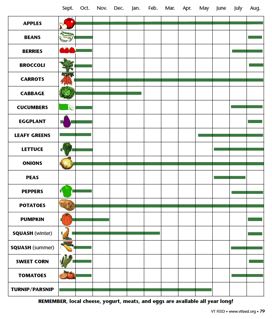 It’s summertime around the USA.
It’s summertime around the USA.
That means a plethora of fresh herbs, vegetables and also some fresh fruits for consumers to enjoy can be found in various Farmer Markets, State & local Fairs, road side stands, community & backyard & sideyard vegetable gardens, grocery stores, convenience stores including bodegas, as well as push carts, food trucks, etc.
In certain instances even area food banks and food pantries are lucky enough to receive some of nature’s abundance to be shared with others.
How can you find out what produce options will be available in your locale during any given month?
(Image source: University of MN Extension Farm to School Toolkit, Vermont Guide to Using Local Food, pg 85 of 116)
Availability of any type of fresh produce is going to be broken down first by broad regions, then by states and finally by locales.
There are a variety of seasonal produce guides that can be located on the www depending upon where you live in the USA. Sometimes these are compiled and released by individual state Cooperative Extension offices (often just called Extension state or local offices) or else other University based programs that are not based at land-grant colleges or universities; and at other times by either not-for-profit or for-profit entities.
You can find out all sorts of information concerning fruits and vegetables from two major sources of produce details, especially through the 2nd site…
- The Centers for Disease Control (CDC) offer the website Fruits and Veggies Matter.
- The Produce for Better Health Foundation in cooperation with its partners and sponsors offers the website Fruits and Veggies More Matters.
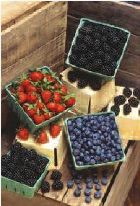 Keep in mind, however, that expected seasonality of produce is always subject to Mother Nature’s whims. For example, normally the strawberry season in our area happens to start around the 2nd week of June. Strange weather patterns over the winter into spring and now into summer have altered that timeline. Strawberry picking times started in May and a smaller crop overall is expected regionally, which means prices are up this year.
Keep in mind, however, that expected seasonality of produce is always subject to Mother Nature’s whims. For example, normally the strawberry season in our area happens to start around the 2nd week of June. Strange weather patterns over the winter into spring and now into summer have altered that timeline. Strawberry picking times started in May and a smaller crop overall is expected regionally, which means prices are up this year.
(Farmstead Berries image courtesy of Rutgers Extension,NJ)
Even farther east of here in the Capital Region (Albany, NY vicinity), the “pick your own” strawberry season this year is not what it was other years. In a News 10 now story, the owner of one such strawberry farm noted “This year the lack of snow cover was a big issue because we normally cover the berries in straw and then we normally get snow and it covers them and insulated them. This year we had no cover, just the straw, and some of the straw blew off and so the plants were exposed.” The reporter went on to note in his conversation with the strawberry farmer that the “early heat in March also did not help the strawberry season. The plants were unable to grow properly because the weather changed from cold to hot, then hot to cold.”
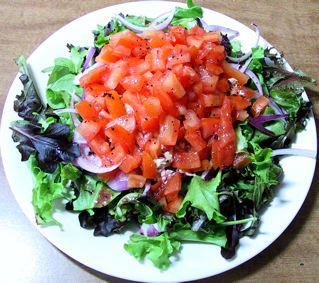 A few of our favorite regional or state or local harvest guides are as follows.
A few of our favorite regional or state or local harvest guides are as follows.
A number are “Gantt style charts” having the months and/or seasons on a horizontal axis and the vegetables and fruits on a vertical axis, noting in some instances both local harvest times and then sometimes what is being brought in from other areas (thus available fresh, but not necessarily sourced regionally, within that state, or locally).
If you live in a colder weather region, you have to adapt and understand a lot of fresh produce will have to be sourced from elsewhere for much of the year. (Salad photo ©Stephanie B-H/SensoryNutrition/US11 shows fresh produce that was NOT regionally sourced, but properly brought in fresh from outside our area & still tasted delicious!)
Any produce guide that is cold region based will reflect minimal typical availability of fresh produce nationally. Availability in your region may vary.
Vermont Food Education Every Day aka Vermont FEED offers a pretty comprehensive piece that also includes a simple colorful guide for school year availability of produce (thus starts with the month of September) which is featured in the opening graphic for this blog post.
Considering the short growing season in North Dakota (ND), we find their colorful In Season Harvest Calendar to remind one of the “national” minimum availability times–growing seasons obviously will be extended in warmer areas of the USA so check out wherever you are to be inspired by potential “fresh” produce options. The only drawback to the ND calendar graphic is that it has produce on the horizontal axis and months on the vertical axis, making it a tad harder to read at a glance.
There is a nice Mid-Atlantic States guide available courtesy of Harvard.
There is an equally nice New England States guide also available courtesy of Harvard.
Cornell Extension has available a Northeastern Regional Food Guide.
Alabama puts out a warmer weather states Seasonal Guide for Fruits and Vegetables.
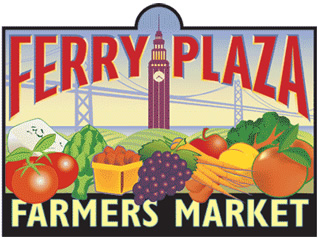 On the opposite coast out West in the California San Francisco, Bay area, The Center For Urban Education About Sustainable Agriculture (CUESA) housed at the Ferry Plaza Farmers Market has available a local seasonal fruit chart and then a local seasonal vegetable chart, which were combined and converted into an infographic by Column Five Media and Visual News.
On the opposite coast out West in the California San Francisco, Bay area, The Center For Urban Education About Sustainable Agriculture (CUESA) housed at the Ferry Plaza Farmers Market has available a local seasonal fruit chart and then a local seasonal vegetable chart, which were combined and converted into an infographic by Column Five Media and Visual News.
(Ferry Plaza Farmers Market Logo property of CUESA and shown for identification purposes only–if you are in the SF Bay Area, check it out!)
University of Georgia’s Cooperative Extension Service puts out some information on Cooking Basics (sourced from a Jane Brody cookbook) which covers some basics for usable weights and measures of some fruits and vegetables to keep in mind when working with new recipes.
Pride of New York has available a visual for produce availability throughout New York State (NYS).
Utah also has available a visual for harvest dates for produce.
The Vermont Food Bank also offers an interesting piece with its seasonality guide, recipes and more.
University of Georgia’s Cooperative Extension Service puts out a Guide to Storing Fruits and Vegetables.
University of Nebraska (Lincoln) Extension puts out 13 Fun Ways to Eat More Fruits and Vegetables.
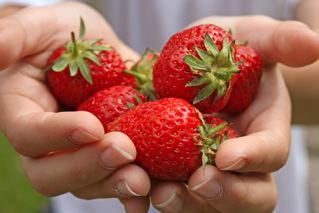 North and West of our roots in NYS is a nice farm & garden business (Chuck Hafner’s Farmers Market & Garden Center) open all week long during harvest season that also has a more temperature controlled indoor farm stand with, for example, veggies kept on ice as needed. Sometimes it is worth a drive up there and back during harvest time here in NY–alas, I forgot to bring a camera last fall. I always travel with an insulated cooler with blue ice inside for such trips and love filling it up with nature’s bounty from my own county. (Strawberries image courtesy of woodsy at rgbstock.com)
North and West of our roots in NYS is a nice farm & garden business (Chuck Hafner’s Farmers Market & Garden Center) open all week long during harvest season that also has a more temperature controlled indoor farm stand with, for example, veggies kept on ice as needed. Sometimes it is worth a drive up there and back during harvest time here in NY–alas, I forgot to bring a camera last fall. I always travel with an insulated cooler with blue ice inside for such trips and love filling it up with nature’s bounty from my own county. (Strawberries image courtesy of woodsy at rgbstock.com)
Right now in our area, the Clinton Square based Farmers Market is open 7 AM-4 PM on Tuesdays, and the Central New York Regional Market is open on Thursdays and Saturdays for fresh produce sales and more.
In case you happen to visit Central New York, check out this blog post for when some local Farmers Markets are open in certain spots around Cayuga, Cortland, Madison, Oneida, Onondaga, Oswego, Seneca, and Tompkins counties.
Many towns and cities have their own smaller Farmers Market locations. You should check for details in any area where you live and/or travel to in order to find out what might be open when. There really is nothing like the taste of the freshest possible produce–Enjoy!


Some grocery stores also have signs saying which local produce will be in at what times. I was shopping yesterday and noticed that Wegmans has such signs right as you walk into the store.
Wegmans definitely is a very consumer oriented store and does feature a section of their website that zeroes in on fresh produce within the states the chain currently has stores in (MA, MD, NJ, NY, PA, VA). They call it “Fresh from the Field to Your Store.”
Anyone can find out for any of those states when “locally grown” produce is anticipated to be arriving through the fall season by state.
Here are the links as of the date this reply is posted for those anticipated fresh produce arrivals:
MA:
http://www.wegmans.com/webapp/wcs/stores/servlet/ProductDisplay?partNumber=CONTENTLIST_39499&catalogId=10002&storeId=10052&langId=-1
MD:
http://www.wegmans.com/webapp/wcs/stores/servlet/ProductDisplay?partNumber=CONTENTLIST_39500&catalogId=10002&storeId=10052&langId=-1
NJ:
http://www.wegmans.com/webapp/wcs/stores/servlet/ProductDisplay?partNumber=CONTENTLIST_39496&catalogId=10002&storeId=10052&langId=-1
NY:
http://www.wegmans.com/webapp/wcs/stores/servlet/ProductDisplay?partNumber=CONTENTLIST_39495&catalogId=10002&storeId=10052&langId=-1
PA: http://www.wegmans.com/webapp/wcs/stores/servlet/ProductDisplay?partNumber=CONTENTLIST_39497&catalogId=10002&storeId=10052&langId=-1
VA:
http://www.wegmans.com/webapp/wcs/stores/servlet/ProductDisplay?partNumber=CONTENTLIST_39498&catalogId=10002&storeId=10052&langId=-1
Enjoy!